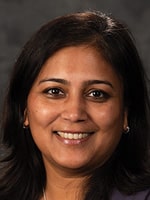Karen Titus
December 2023—The recent CAP proficiency testing questionnaire was meant to be the coup de grâce. Hematology PT participants were asked about their band neutrophil reporting practices and, given that these manually generated counts were supposedly on their way out decades ago, the authors of the survey questionnaire expected to see very little activity. The survey, they hoped, would be a way to pound the final, data-driven nail in the coffin.
Or, as lead author Maria (Ria) Vergara-Lluri, MD, puts it, “We thought this had all been laid to rest 30 years ago.”
It wasn’t. Says Dr. Vergara-Lluri: “Surprise: 86 percent of labs that participated still report bands.”
The results of the survey (Vergara-Lluri M, et al. Arch Pathol Lab Med. Published online Aug. 28, 2023. doi: 10.5858/arpa.2023-0015-CP) upended many of the assumptions, if not hopes, the authors might have had.
Among laboratories that reported manual differentials, they found that most reported bands (4,554 of 5,268). Moreover, only 73 percent reported band reference ranges.
On the morphologic challenge, bands classified as “easy” were indeed easy—participants classified them well (78 to 98.3 percent of respondents). But categorization of cell identifications for “moderate” and “difficult” bands was poor (3.1 to 39 percent of respondents), with classification instead as segmented neutrophils.
Moreover, there were no winners. Whether the laboratory was small, medium, or large, community based or academic, they all did poorly.
Now, instead of using the data to nail the lid shut, the authors will have to persuade physicians to first build a casket and put the body in it.
The authors, all of whom are current or former members of the CAP Hematology/Clinical Microscopy Committee, were spurred to do the survey in part because of band counting-related inquiries that coauthor Parul Bhargava, MD, found herself answering in CAP TODAY’s “Q&A” column.
“This was really Parul’s brainchild,” says Dr. Vergara-Lluri, associate professor of clinical pathology and attending hematopathologist, Keck School of Medicine of USC (University of Southern California) and Los Angeles General Medical Center.

Dr. Bhargava
For her part, Dr. Bhargava, professor of pathology and laboratory medicine and senior laboratory director, University of California San Francisco, says that despite numerous publications that have shown band counting is unreliable and of questionable utility, “I was explaining, over and over again in CAP TODAY, the same thing.” Others on the committee—with its high representation of academic medical centers—had already stopped reporting bands. “So the perception in the room was that the questions we were getting might represent a minority of folks. But we didn’t have formal data to back that up.”
Alas, they still don’t. Band counting was not, as it turns out, a rare artifact from a past era. “That was the biggest surprise—just the sheer number of people who are still reporting bands,” Dr. Bhargava says.
“Here we are,” agrees Dr. Vergara-Lluri, surveying the results and noting that a key article on the utility (or rather, lack of it) of band counting published three decades ago (Cornbleet PJ, et al. CAP TODAY. 1994;8[5]:37–41) should have solved the problem far sooner. Channeling her inner Stephen Sondheim, she adds, “We’re still here.”
This is not a glowing tribute to longevity. In the laboratory, “We all know this is not great,” says Dr. Vergara-Lluri, who is also medical section director of hematology and flow cytometry sections for the core laboratory of Los Angeles General Medical Center.

Band neutrophils were found to be commonly reported by a majority of surveyed laboratories. “It’s labor-intensive, it’s manual, it will delay turnaround time, and it siphons medical scientists’ resources” away from tests with greater clinical value and higher reproducibility, says Dr. Maria (Ria) Vergara-Lluri, at right. [Photo by Roland DeCrescent]
That knowledge may be well known in the echo chamber of the laboratory community, Dr. Vergara-Lluri says, but it’s not widespread among clinicians, whose literature sometimes proposes a different story: that band counts are useful for sepsis evaluation. “Some pediatricians and hematology oncologists are still hanging on to the idea that this is essential.”
Dr. Vergara-Lluri recalls one study that suggested that a small apparent change in a patient’s band neutrophils—say from three percent one day to seven percent the next—was clinically significant. But such studies can overlook the impact of Rumke intervals, the Archives study notes. As Dr. Vergara-Lluri explains, if a technologist counts seven percent bands in a 100-cell manual differential, the 95 percent confidence interval is two to 12 percent. “It’s wide. We laboratorians understand that.” But that nuance may be lost on clinicians, who may confer an unwarranted perfection on a laboratory result in the electronic medical record. “They think that seven percent is always going to be seven percent—today, tomorrow—and it means something when it jumps to 10 or even 12 percent,” rather than falling within statistical probabilities.
At the same time, the authors knew they had to dig deeper into the practices of their laboratory colleagues, says Dr. Bhargava. Are they reporting percents? Absolute counts? Reference ranges? Are they reporting it in specific scenarios? At the behest of certain divisions like the NICU or hematology-oncology?
Secondly, Dr. Bhargava continues, while they knew some laboratories were still reporting band counts, “We also wanted to further drive home the point about its inaccuracy.”
To do so they selected a peripheral blood smear from a neonate admitted shortly after birth for decreased movement and depressed respiratory rate with Apgar scores of three, seven, and eight at one, five, and 10 minutes; the most common clinical scenario for band count requests is neonatal sepsis, the authors note. The morphologic challenge included a dozen preselected cell identifications of segmented neutrophils, bands, and metamyelocytes, representing easy, moderately challenging, and difficult-to-classify bands.
In addition, they asked whether those performing band counts in the laboratory were specialists or generalists, and whether they performed counts manually or used an image analysis platform.
That led to another surprise. “It didn’t matter,” Dr. Bhargava says. “It was equally bad for everyone.”
Given that interobserver variability in classifying a given cell is impacted by the way the nucleus may “kink” or “fold,” it’s “poor no matter what you do to try to improve it,” Dr. Bhargava says.
No amount of training is likely to solve the problem. To those outside the laboratory, Dr. Vergara-Lluri says, the issues with identifying band neutrophils might seem to be related to technologists’ skills. She’s quick to disabuse folks of that notion. “Someone might say, ‘You just don’t train your techs well enough.’ But they’re very good at their jobs.”
The authors did explore the hypothesis that laboratory training would make a difference. Would results be better in laboratories staffed by those trained only in hematology, for example, or those who performed higher volumes? “We asked all those questions,” says Dr. Vergara-Lluri. There was no reproducible, consistent linkage between such factors and performance. “Which just means that it’s hard to count bands.”
Band neutrophils are by their nature difficult to identify. In moderate and difficult cell identifications, it’s difficult to identify the filament that distinguishes between a segmented neutrophil and a band neutrophil. “You’re not quite sure—I’m not seeing it but maybe it’s there?” Dr. Vergara-Lluri says. “It’s easy when it’s easy, but when it’s moderate and difficult, that’s where the ambiguity rests.”
If the nucleus has an identifiable thin filament connecting two or more lobes, Dr. Bhargava explains, then it’s considered a segmented neutrophil. Anything short of that, she says, would be a band. But constrictions can pose a problem. “It lies in the eyes of the beholder whether the constriction is thin enough to be a filament, or is it really just a constriction.”
Another problem lies with the manual nature of band counting. Most labs will perform a 100- or 200-cell differential, which leads to the wide statistical confidence interval of the count, says Dr. Bhargava; by comparison, an automated differential counts around 30,000 cells.
The survey also asked participants to perform a manual 100-cell differential on a single digital blood smear. “Even then the CV of the labs was really high—55.8 percent,” Dr. Vergara-Lluri says. One laboratory called a minimum of zero percent bands; another a maximum of 50 percent bands, on the exact same digitized smear. “That’s not very reproducible.”
What should laboratories do with this dispiriting data?
Dr. Vergara-Lluri sighs, then begins listing some options.
One tack would be to make it part of a laboratory stewardship initiative, she says, approaching the C-suite with a proposal to use the laboratory more wisely. With a shrinking workforce, and plenty of other manual demands in the hematology laboratory, “I don’t want our technologists spinning their wheels. Removing band counting would relieve the manual work that’s really not valuable,” Dr. Vergara-Lluri says.
“But I think we also have to have these conversations with our clinical colleagues,” she adds. “One way is to say, ‘I will provide you with quality care in tests that actually have good reproducibility, and we’ll improve your care. That’s not the case with band counts. It’s archaic, and we need to do something better and not tie up technologist time.’”
In her experience, hematology-oncology and pediatrician colleagues tend to be more conversant in the nuances of band counting. “They don’t use it,” Dr. Vergara-Lluri says, though she adds that the survey data indicated those two practices are a bit more likely to order it.
She’s encountered more pushback from generalists. She recently tried to persuade one clinical colleague to stop ordering CBCs with manual differentials to obtain a band count. “We know that having the manual differential tacked onto the CBC will increase turnaround times. Unfortunately, I hit a brick wall with this particular physician,” who insisted band counts were essential to identifying patients with sepsis. “No amount of data I could present would change their mind,” she says.
 CAP TODAY Pathology/Laboratory Medicine/Laboratory Management
CAP TODAY Pathology/Laboratory Medicine/Laboratory Management
